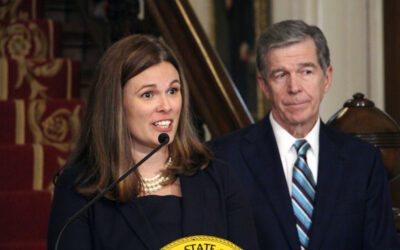
Photo courtesy of The Good of the Hive
How a chance encounter with a bee inspired an artist to paint 50,000 honeybees across the world. Today, 11 NC cities feature his murals.
In 2008, art activist Matt Willey met a bee in his Manhattan studio. That encounter would lead to The Good of the Hive, Willey’s mission to paint 50,000 honeybees worldwide.
“She flew in and landed right in the middle of the rug: ‘Notice me!’” Willey explains. “She was walking and not flying. I wasn’t freaked out like she was going to sting me.
“I got out my magnifying glass, and I noticed a cuteness to this little bug. She was fuzzy with these big eyes, and I loved the stripes. I had a spiritual connection with this little bug I had never noticed before.”
Read More: Gas station sushi, anyone? A new book from a NC author dives into convenience store cuisine in the South.
Through The Good of the Hive, Willey has painted 50 murals since 2015. More than 10,500 bees buzz across buildings and structures throughout the world. Many North Carolina cities—Asheville, Carrboro, Chapel Hill, Charlotte, Columbia, Durham, Gastonia, Hendersonville, Raleigh, Weaverville, and Wendell—have commissioned at least one mural by Willey.

Photo courtesy of The Good of the Hive
Bee-search
Willey stayed with the bee until she died a few hours later. He began researching honeybees and learned about Colony Collapse Disorder, an unfamiliar concept in 2008. “Millions of bees were dying all over the world,” he explains. “Nobody knew why. No one was talking about this globally devastating thing.”
He kept digging and came across altruistic self-removal, a behavior seen in insects such as honeybees. If the bee feels sick, they exit the hive and fly off, for the good of the hive.
“They would take this drastic action because they are hard-wired to understand their health is connected to the hive, not their individual bee body,” Willey says. “We are hard-wired for choice. We need each other to survive; our health is based on our collective interaction. Yet we don’t act like it. It was like a lightning bolt moment for me.”
From idea to action
By 2015, Willey was obsessed with bees, he says. He’d continued researching and talking with people about bees — Willey’s friends were well-acquainted with his quest to raise awareness by painting a mural.
A friend sent him a video of a blank wall in LaBelle, Fla. It happened to be on the side of Harold P. Curtis Honey Co., a family-owned business that sells honey and keeps bees. When Willey reached out to ask if they wanted a mural on the side of their building, they said “yes,” but added that they didn’t have money to pay Willey, and it was illegal to paint a mural in LaBelle.
Two months later, after that law was changed, Willey was bound for Florida to paint his first bee mural. A crowdsourced fundraising campaign helped him with gas money. He lived in a borrowed RV for 10 weeks while he worked. Local business owners gave him free breakfast and lunch. A few people dropped off jars of honey for Willey to sell for cash.
After a local newspaper article found its way to social media, donations from all over the country started coming in, including funds from competitors — other honey companies.
The mural site became a gathering place for people of all ages and backgrounds. “There was an energetic connection,” he says. “It was a vehicle for sharing stories that were about something we’re all connected to. Where there are people in the world, there are bees.”
Hendersonville’s bees
Kim Bailey, owner of Milkweed Meadows Farms in Fruitland, became involved in The Good of the Hive project in Hendersonville because of her connection to Bee City USA, a nonprofit founded in Asheville. Willey had contacted the Hendersonville chapter of Bee City USA to see if they were interested in a mural.
It took three years to secure the details of the mural. HandsOn! Children’s Center in downtown Hendersonville was chosen as the location, and Bailey sold milkweed plants and other pollinator plants at the annual Garden Jubilee to raise funds. When the pandemic hit in 2020, everyone wanted to start gardens and Bailey reached the fundraising goal quickly.
Willey started the mural in the fall of 2020 and returned in the spring of 2021 to finish. During those last six weeks, he lived on Bailey’s farm and witnessed the lifecycle of the monarch butterfly in the pollinator-rich environment. Although an adult monarch was always included in the design, Willey added an egg, a caterpillar, and two versions of a chrysalis to the mural.
A demonstration garden, funded through Visit Hendersonville, was installed in front of the mural. Plants supporting pollinators such as monarch butterflies and bees grow along the sidewalk.
The garden is an EcoExplore Hot Spot, a nature education program for kids through The North Carolina Arboretum.

Photo courtesy of The Good of the Hive.
“Matt is more than a talented artist,” Bailey says. “He is so knowledgeable about honey bees and other pollinators. We wanted this to be an educational awareness project, not just a beautification of downtown. He could speak with expertise about pollinators as he was painting them.”
It wasn’t unusual for Bailey to bring educational displays for visitors to view while Willey painted. On the last day, Bailey had chrysalides in an aquarium.
“The first four butterflies emerged the final day he finished the mural,” she says. “We released them a few hours later and one landed on the mural wall and hung out with him for the rest of the afternoon.”
This article first appeared on Good Info News Wire and is republished here under a Creative Commons license.

North Carolina’s Lumbee Tribe hoping for a long-awaited federal recognition
North Carolina's Lumbee have been waiting for generations for the federal government to fully recognize them, bringing with it financial benefits...

The North Carolinian delivering campers & hope to western NC after Helene
We spoke to Gary Pigg, a Cabarrus County resident who delivered more than 220 campers to residents after Tropical Storm Helene. Last September,...

Why did this Wisconsin community rally to expand public transportation? To fight loneliness.
The case that locals made for expanding transportation service to Sundays was different. They argued that the people of Walworth County didn’t only...

Why did this Wisconsin community rally to expand public transportation? To fight loneliness.
The case that locals made for expanding transportation service to Sundays was different. They argued that the people of Walworth County didn’t only...

The future chefs of North Carolina: 5 high school teams compete in cooking competition
High school culinary teams compete in the North Carolina Jr. Chef Competition, showcasing cooking skills and local ingredients while creating...








